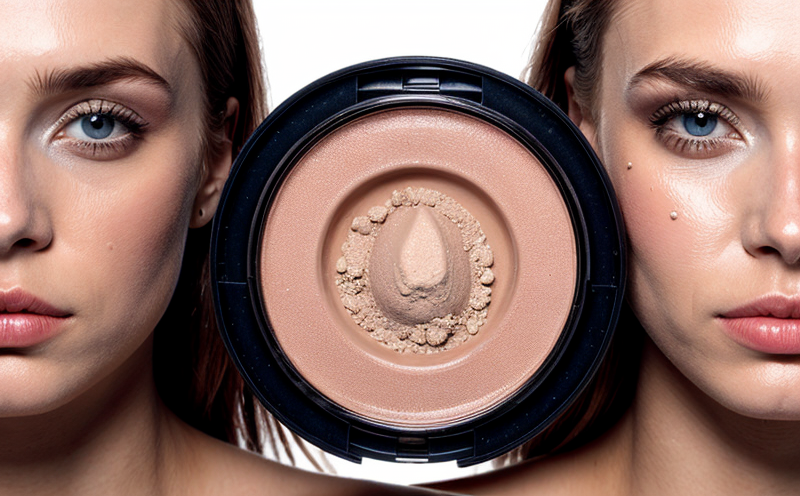Cosmetic Contamination Testing by ICP-OES
The use of cosmetics has become an integral part of daily life, especially in sectors such as beauty and personal care. Ensuring these products are free from harmful contaminants is critical for the health and safety of consumers. One effective method to achieve this is through ICP-OES (Inductively Coupled Plasma Optical Emission Spectroscopy), a precise analytical technique that can detect heavy metals and other potential contaminants in cosmetic formulations.
The primary function of ICP-OES testing is to identify trace amounts of harmful elements, such as lead, mercury, arsenic, cadmium, and chromium. These heavy metals are known for their toxicity even at low concentrations, making it essential to ensure they do not exceed regulatory limits set by standards like ISO 21964. This test is particularly important in the cosmetics sector, where product safety is paramount.
The process involves a series of steps. First, the cosmetic sample undergoes thorough preparation, which may include digestion using strong acids to break down complex compounds into simpler ions. Once prepared, the solution is introduced into an ICP-OES instrument. This instrument excites the sample ions through plasma, causing them to emit characteristic light spectra. These emissions are then measured and analyzed by a spectrometer.
The accuracy of this method lies in its ability to detect minute traces of metals down to parts per million (ppm) levels. The precision ensures that even the smallest amounts of contaminants can be identified and quantified, which is crucial for maintaining product safety standards. Compliance with regulations such as US FDA 21 CFR Part 73 and European directives like ECB 1689/2015 is essential to ensure that cosmetic products are safe for use.
ICP-OES testing offers several advantages over other analytical methods. It provides high throughput, meaning it can process multiple samples efficiently in a short time. Additionally, the method has excellent sensitivity and selectivity, allowing for accurate detection of even trace amounts of contaminants. The technique is also relatively inexpensive compared to some other advanced techniques.
In conclusion, ICP-OES testing plays a vital role in ensuring the safety of cosmetics by identifying potential contaminants that could harm consumers. Its accuracy, efficiency, and cost-effectiveness make it an indispensable tool for quality managers, compliance officers, R&D engineers, and procurement specialists working in the cosmetics industry.
Benefits
The benefits of using ICP-OES for cosmetic contamination testing are numerous. Firstly, this method ensures that products meet stringent safety standards set by regulatory bodies worldwide. This compliance is critical to avoid legal issues and maintain consumer trust. Secondly, the high accuracy and precision of ICP-OES provide reliable data that can be used to improve product formulations continuously.
Thirdly, the ability to detect trace amounts of contaminants early in the manufacturing process allows for timely corrective actions, minimizing the risk of recall and associated costs. Fourthly, ICP-OES testing supports sustainable practices by enabling the identification and removal of harmful substances from cosmetic products, promoting a safer environment.
In addition, this method enhances brand reputation by ensuring that cosmetics are safe and reliable. This is especially important in today’s highly competitive market where consumer health and safety are key differentiators. Lastly, ICP-OES testing fosters innovation by allowing R&D engineers to explore new formulations without compromising on quality standards.
Quality and Reliability Assurance
The reliability of the test results is paramount in ensuring product safety. To achieve this, laboratories using ICP-OES for cosmetic contamination testing follow strict protocols. These include rigorous calibration procedures to ensure that the instrument operates within specified parameters. Regular maintenance and calibration checks are performed to maintain accuracy.
Laboratories also employ quality control measures such as running blank samples and spiked samples (samples with known concentrations of contaminants) to verify the reliability of test results. This ensures consistency across multiple tests, making it easier for manufacturers to trust the data generated by ICP-OES testing.
Moreover, laboratories adhere to international standards like ISO 17025 for quality management systems and ISO/IEC 17026 for proficiency testing. These standards provide a framework for continuous improvement in laboratory operations, ensuring that results are accurate and reliable.
Customers can rest assured knowing that the data provided by ICP-OES tests is not only precise but also meets the highest quality assurance standards. This commitment to excellence ensures that consumers receive safe and high-quality cosmetic products.
Customer Impact and Satisfaction
The impact of reliable ICP-OES testing on customers is significant. Firstly, it directly contributes to consumer safety by ensuring that cosmetics are free from harmful contaminants. This reduces the risk of adverse health effects associated with heavy metal exposure.
Secondly, meeting regulatory standards enhances brand reputation and credibility. Consumers trust brands that demonstrate a commitment to product safety and quality. This positive image can lead to increased customer loyalty and repeat purchases.
Thirdly, timely identification of potential issues through ICP-OES testing allows for proactive measures to be taken, minimizing the risk of product recalls. Recalls not only damage brand reputation but also incur significant costs. By preventing such incidents, customers benefit from reduced disruptions in supply chains and lower prices due to efficient production processes.
Fourthly, innovation is fostered by reliable data provided through ICP-OES testing. This enables R&D teams to explore new ingredients and formulations without compromising on safety standards. Consumers ultimately benefit from a wider range of safe cosmetic products.
In summary, the impact of ICP-OES testing on customers extends beyond product safety; it encompasses brand reputation, customer loyalty, efficient supply chains, and access to innovative products. These factors contribute to overall satisfaction and trust in the cosmetics industry.





